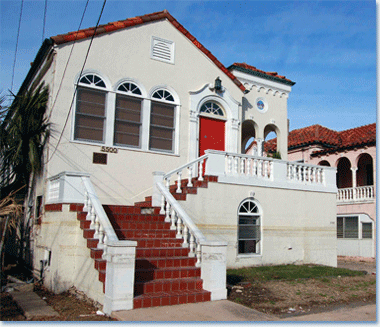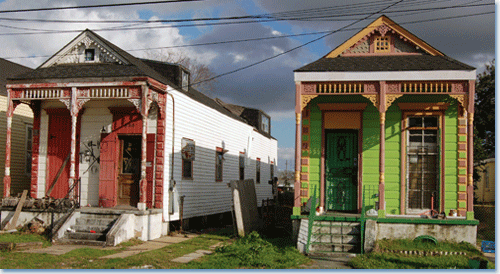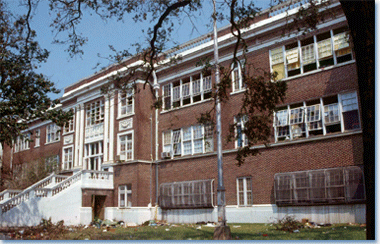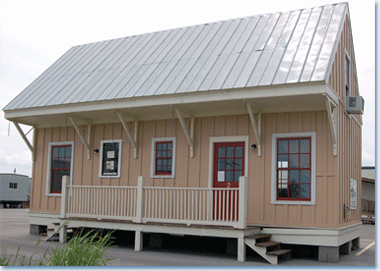 Hurricane Katrina has reshaped New Orleans. The 2005 storm's impacts accelerated a slow-moving population loss and recalibrated the city's racial demographics. Disruption and displacement reduced municipal revenues and reverberated through local politics. Wind, water, and mold seriously damaged much of the city's distinctive architecture. No person, neighborhood, institution, or organization was unaltered.
Hurricane Katrina has reshaped New Orleans. The 2005 storm's impacts accelerated a slow-moving population loss and recalibrated the city's racial demographics. Disruption and displacement reduced municipal revenues and reverberated through local politics. Wind, water, and mold seriously damaged much of the city's distinctive architecture. No person, neighborhood, institution, or organization was unaltered.
As the city reached the five-year mark after the storm, the Brookings Institution touted the city's resilience—its capacity to rebound from a devastating event. Some commentators use the term "resilience" to refer to a dogged determination, a will to persevere. For others it more closely corresponds to the term's use by environmental scientists who use it to mean the ability to respond to devastation and restore conditions to the way they were before a disruptive event.
Without a doubt, the city is rebuilding, although the pace and comprehensiveness has earned both praise and criticism. At the seven year mark, much has been accomplished and sizable areas bear little or no trace of the storm. Other neighborhoods will never be what they were before August 2005—thousands of vacant lots denote failed attempts to erase the storm's destruction. Beyond the visible landscape, human inequities in terms of both the impacts and the recovery are well known.
Stepping back and looking at the persistence of New Orleans in the face of many calamities, one must acknowledge a certain degree of perseverance. The city has endured at least 27 major floods since its founding in 1718. It has coped with two military invasions, numerous yellow fever epidemics in the 19th century, water-supply crises, and economic recessions tied to both the nation's fortunes and the local energy economy. Unquestionably, the city has endured—but never in an unaltered form.
For a city with an economy built on its history, New Orleans has done a poor job remembering its encounters with past disasters. Indeed, comparing the preparations for and responses to Hurricane Betsy in 1965 with comparable practices in 2005 does not speak highly of the city's capacity to translate lessons from past events into survival strategies.
Resilience before Betsy
Adaptation to local conditions was evident in several different areas of urban life in New Orleans before 1965. Domestic architecture incorporated flood-proof design and materials and the urban footprint took advantage of the limited topographic high ground. Frequent flooding prompted French settlers to adopt architectural techniques favored in the Caribbean that elevated the living quarters five to six feet above ground level on brick piers. This design allowed air circulation and some relief from the oppressive heat, raised inhabitants above the zone of densest mosquito activity, and provided protection from the regular spring floods. It became a signature of the wealthy planters' homes along the Mississippi River and was common in the city as well. Raised houses continued to be a common feature into the 20th century, particularly among lakefront homes susceptible to hurricane storm surge. Even 1920s houses built in low-lying sections of the city stood well above street level, reflecting a continuation of flood-proof architecture (Figure 1).
 The most ubiquitous houses in New Orleans, the "shotgun" and the larger "double shotgun," used water-resistant building materials (Figure 2). Lumber cut from Louisiana's ancient cypress forests was both rot and termite resistant and provided the building material for the expansion of New Orleans after the Civil War. Working-class housing built of cypress and raised 3 to 4 feet above the ground proved to be highly effective against flooding. Consequently the housing stock of the city in 1965 was amazingly flood resistant.
The most ubiquitous houses in New Orleans, the "shotgun" and the larger "double shotgun," used water-resistant building materials (Figure 2). Lumber cut from Louisiana's ancient cypress forests was both rot and termite resistant and provided the building material for the expansion of New Orleans after the Civil War. Working-class housing built of cypress and raised 3 to 4 feet above the ground proved to be highly effective against flooding. Consequently the housing stock of the city in 1965 was amazingly flood resistant.
The urban land use and large-scale flood protection systems protected the city from inundation. On the eve of Hurricane Betsy, the residential and commercial core of the city was on the highest ground, the narrow natural levee paralleling the river atop the Metairie and Gentilly ridges—natural levees from past geologic ages. The city was growing off the high ground, toward Lake Pontchartrain in particular. After severe flooding in 1915, the city began constructing a hurricane protection levee along the lakefront. This structural barrier was intended to fend off surges and waves produced by future storms and thereby offset the vulnerability of new developments moving toward the zone of highest risk. Postwar suburban growth was moving into upstream Jefferson Parish and onto flood-exposed areas, but the majority of residents lived in relatively safe locations. Nonetheless, suburban growth into flood prone areas and new building practices foretold problems to come.
Comparing Resilience
When Hurricane Betsy made landfall in September 1965, the city suffered unprecedented damage. The storm surge roared into the city from the east, inundated 43 percent of the city, seriously damaged 15,000 homes, and left 81 dead. Within days of the storm, Governor John McKeithen testified to Congress that his administration would "establish procedures that will someday in the near future make a repeat of this disaster impossible." Yet when Katrina arrived in 2005, with peak wind speeds in the city of less than 90 miles per hour, it overwhelmed an unfinished hurricane protection system, inundated 80 percent of the city, and left over 1,000 dead. The more severe impacts caused by a lesser storm suggests a serious weakening of the defenses and loss of resilience in the four decades between the storms.
 The pace of the emergency response and initial recovery following the two storms is revealing. Large department stores were open within two days of the September 9, 1965, landfall of Betsy. Major intercity transportation was near normal within three days, and conventions had resumed within a week. In less than two weeks crews had restored power and other utilities to 90 percent of residents and completed pumping out the flood water. All schools had reopened before the one month anniversary. By most measures, the city was back in business after a mere 30 days. After Katrina's August 29, 2005, landfall, the damage was far more extensive and both the emergency response and short-term recovery were more protracted. It took crews nine months to reach 90 percent service for electricity, water, sewerage, and gas. Most schools did not reopen until January 2006 (Figure 3). There was a nine-month moratorium on major conferences, and public transit and hospital services were at 50 percent of pre-storm levels at the one-year mark.
The pace of the emergency response and initial recovery following the two storms is revealing. Large department stores were open within two days of the September 9, 1965, landfall of Betsy. Major intercity transportation was near normal within three days, and conventions had resumed within a week. In less than two weeks crews had restored power and other utilities to 90 percent of residents and completed pumping out the flood water. All schools had reopened before the one month anniversary. By most measures, the city was back in business after a mere 30 days. After Katrina's August 29, 2005, landfall, the damage was far more extensive and both the emergency response and short-term recovery were more protracted. It took crews nine months to reach 90 percent service for electricity, water, sewerage, and gas. Most schools did not reopen until January 2006 (Figure 3). There was a nine-month moratorium on major conferences, and public transit and hospital services were at 50 percent of pre-storm levels at the one-year mark.
Living with Powerful Nature
Observers of the post-Katrina recovery point toward entrepreneurial enthusiasm and vigorous civic engagement in the past seven years. There are parallels in the post-Betsy response. Leaders in 1965 fought to secure funding for a mighty flood defense system which initially moved forward with great speed. Yet squabbles over funding and the territories to be protected slowed the progress of levee building. As is common after disruptions, the memory of the tragedy faded. Economic growth took priority over safe development. Most new houses were built slab-on-grade with building materials that would not stand up to inundation. The city rushed to permit new subdivisions in the very areas that had flooded in 1965. Suburban development pushed into the areas that had been avoided for centuries. Resilience eroded as quickly as the Louisiana coast.
 Despite the grand claims of recovery since Katrina, I wonder if it will be sustained. Already there are disturbing signs. After the storm, architects developed what came to be known as the "Katrina cottage"—a small house based on traditional local designs, and which would use flood-proof building materials (Figure 4). Not a single one of these sensible structures was built. The initial redevelopment plan called for setting aside wide swaths of flood-prone land as green space to prevent another massive loss of housing stock. But there was a great public outcry as homeowners feared they were being denied the right to return, and the city has encouraged redevelopment in areas that flooded in 2005. In neither residential architecture nor urban land use was the resilient option followed. While restaurants abound and tech start-ups flourish as one measure of entrepreneurial resilience, one needs to ask how will these businesses fare when the next storm arrives?
Despite the grand claims of recovery since Katrina, I wonder if it will be sustained. Already there are disturbing signs. After the storm, architects developed what came to be known as the "Katrina cottage"—a small house based on traditional local designs, and which would use flood-proof building materials (Figure 4). Not a single one of these sensible structures was built. The initial redevelopment plan called for setting aside wide swaths of flood-prone land as green space to prevent another massive loss of housing stock. But there was a great public outcry as homeowners feared they were being denied the right to return, and the city has encouraged redevelopment in areas that flooded in 2005. In neither residential architecture nor urban land use was the resilient option followed. While restaurants abound and tech start-ups flourish as one measure of entrepreneurial resilience, one needs to ask how will these businesses fare when the next storm arrives?
Craig E. Colten is the Carl O. Sauer Professor of Geography at Louisiana State University and author of An Unnatural Metropolis: Wresting New Orleans from Nature (2005) and Perilous Place and Powerful Storms: Hurricane Protection in Coastal Louisiana (2009). He is chair of the 2013 Local Arrangements Committee.
Tags: Annual Meeting 2013 Annual Meeting North America Economic History
Comment
Please read our commenting and letters policy before submitting.






